1988 PONTIAC FIERO boot
[x] Cancel search: bootPage 1140 of 1825
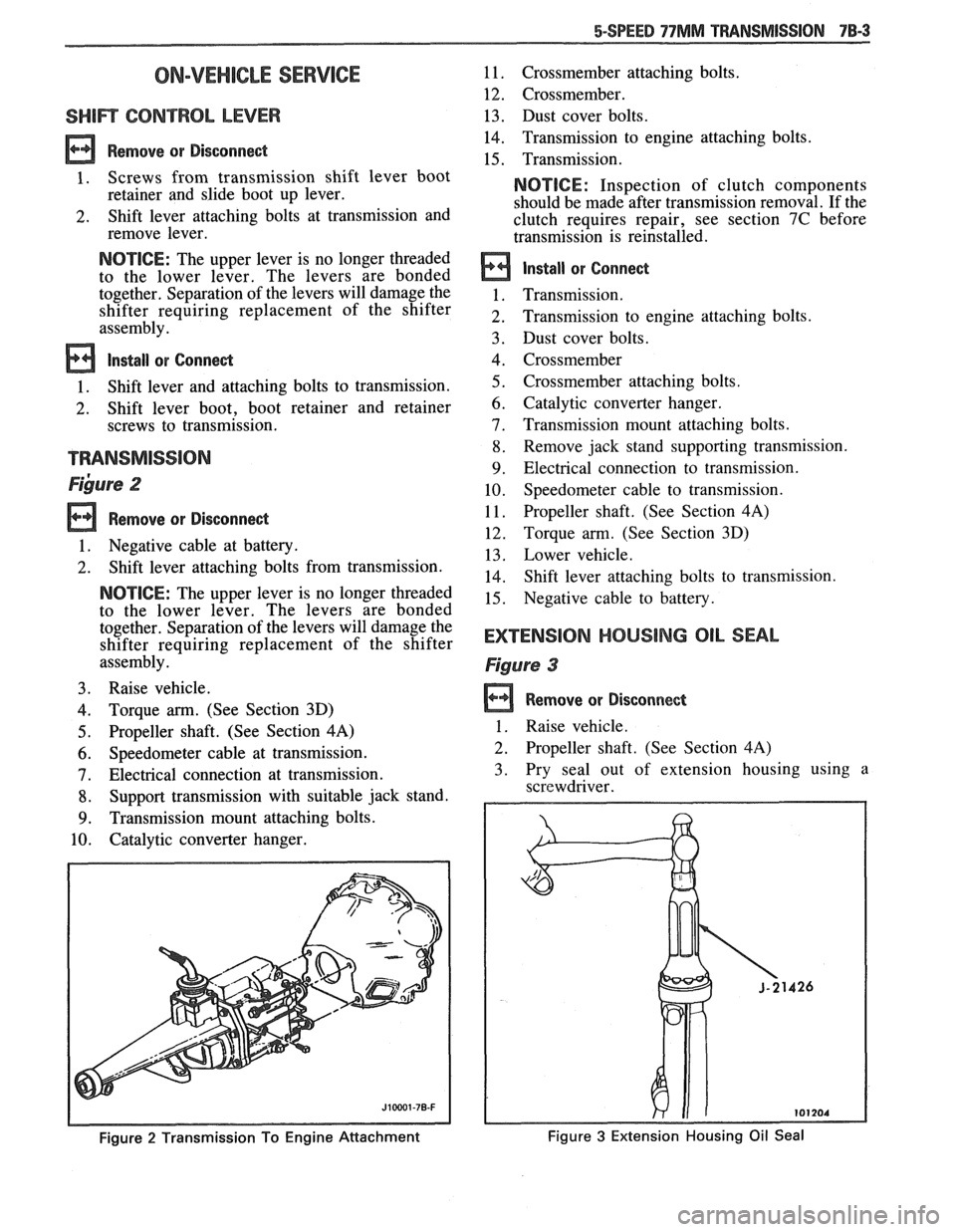
5-SPEED 77MM TRANSMISSION 7B-3
ON-VEHICLE SERVICE
SHlR CONTROL LEVER
Remove or Disconnect
1. Screws from transmission shift lever boot
retainer and slide boot up lever.
2. Shift lever attaching bolts at transmission and
remove lever.
NOTICE: The upper lever is no longer threaded
to the lower lever. The levers are bonded
together. Separation of the levers will damage the
shifter requiring replacement of the shifter
assembly.
Install or Conned
1. Shift lever and attaching bolts to transmission.
2. Shift lever boot, boot retainer and retainer
screws to transmission.
~ibure 2
Remove or Disconnect
1. Negative cable at battery.
2. Shift lever attaching bolts from transmission.
NOTICE: The upper lever is no longer threaded
to the lower lever. The levers are bonded
together. Separation of the levers will damage the
shifter requiring replacement of the shifter
assembly.
3. Raise vehicle.
4. Torque arm. (See Section 3D)
5. Propeller shaft. (See Section 4A)
6. Speedometer cable at transmission.
7. Electrical connection at transmission.
8. Support transmission with suitable jack stand.
9. Transmission mount attaching bolts.
10. Catalytic converter hanger.
Figure 2 Transmission To Engine Attachment
11. Crossmember attaching bolts.
12. Crossmember.
13. Dust cover bolts.
14. Transmission to engine attaching bolts.
15. Transmission.
NOTICE: Inspection of clutch components
should be made after transmission removal. If the
clutch requires repair, see section 7C before
transmission is reinstalled.
Install or Connect
Transmission.
Transmission to engine attaching bolts.
Dust cover bolts.
Crossmember
Crossmember attaching bolts.
Catalytic converter hanger.
Transmission mount attaching bolts.
Remove jack stand supporting transmission.
Electrical connection to transmission. Speedometer cable to transmission.
Propeller shaft. (See Section
4A)
Torque arm. (See Section 3D)
Lower vehicle.
Shift lever attaching bolts to transmission.
Negative cable to battery.
EXTENSlOM HOUSING OIL SEAL
Figure 3
Remove or Disconnect
1 . Raise vehicle.
2. Propeller shaft. (See Section 4A)
3. Pry seal out of extension housing using a
screwdriver.
Figure 3 Extension Housing Oil Seal
Page 1159 of 1825
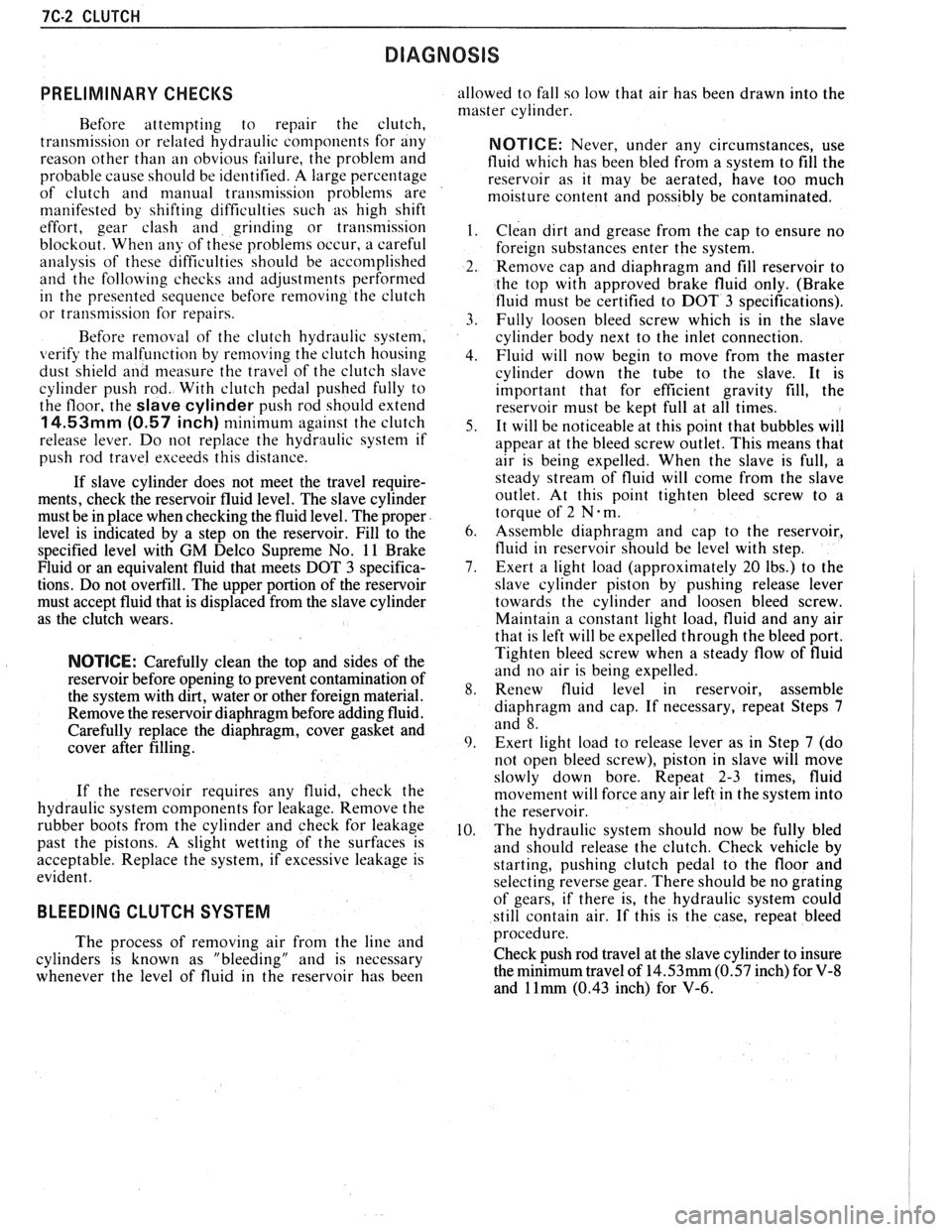
7C-2 CLUTCH
PRELIMINARY CHECKS
Before attempting to repair the clutch,
transmission or related hydraulic components for any
reason other than
an obvious failure, the problem and
probable cause should be identified.
A large percentage
of clutch and manual transmission
problenls are
manifested by shifting difficulties such as high shift
effort, gear clash and grinding or transmission
blockout. When any of these problems occur, a careful
analysis of these difficulties should be accomplished
and the following checks and adjustments performed
in the presented sequence before removing the clutch
or transmission for repairs.
Before
removal of the clutch hydraulic system,
verify the malfunction by renloving the clutch housing
dust shield and
measure the travel of the clutch slave
cylinder push rod. With clutch pedal pushed fully to
the floor, the
slave cylinder push rod should extend
14.53mm (0.57 inch) minimum against the clutch
release lever. Do
not replace the hydraulic system if
push rod travel exceeds this distance.
If slave cylinder does not meet the travel require-
ments, check the reservoir fluid level. The slave cylinder
must be in place when checking the fluid level. The proper
level is indicated by a step on the reservoir. Fill to the
specified level with
GM Delco Supreme No. 11 Brake
Fluid or an equivalent fluid that meets DOT
3 specifica-
tions. Do not overfill. The upper portion of the reservoir
must accept fluid that is displaced from the slave cylinder
as the clutch wears.
NOTICE: Carefully clean the top and sides of the
reservoir before opening to prevent contamination of
the system with dirt, water or other foreign material.
Remove the reservoir diaphragm before adding fluid.
Carefully replace the diaphragm, cover gasket and
cover after filling.
If the reservoir requires any fluid, check the
hydraulic system components for leakage. Remove the
rubber boots from the cylinder and check for leakage
past the pistons. A slight wetting of the surfaces is
acceptable. Replace the system, if excessive leakage is
evident.
BLEEDING CLUTCH SYSTEM
allowed to fall so low that air has been drawn into the
master cylinder.
NOTICE: Never, under any circumstances, use
fluid which has been bled from a system to fill the
reservoir as it may be aerated, have too much
moisture content and possibly be contaminated.
Clean dirt and grease from the cap to ensure no
foreign substances enter the system.
Remove cap and diaphragm and
fill reservoir to
the top with approved brake fluid only. (Brake
fluid must be certified to DOT 3 specifications).
Fully loosen bleed screw which is in the slave
cylinder body next to the inlet connection.
Fluid will now begin to move from the master
cylinder down the tube to the slave. It is
important that for efficient gravity
fill, the
reservoir must be kept full at all times.
It will be noticeable at this point that bubbles will
appear at the bleed screw outlet. This means that
air is being expelled. When the slave is full, a
steady stream of fluid will come from the slave
outlet. At this point tighten bleed screw to a
torque of 2
N .m.
Assemble diaphragm and cap to the reservoir,
fluid in reservoir should be level with step.
Exert a light load (approximately 20 lbs.) to the
slave cylinder piston by pushing release lever
towards the cylinder and loosen bleed screw.
Maintain a constant light load, fluid and any air
that is left will be expelled through the bleed port.
Tighten bleed screw when a steady flow of fluid
and no air is being expelled.
Renew fluid level in reservoir, assemble
diaphragm and cap. If necessary, repeat Steps
7
and 8.
Exert light load to release lever as in Step 7 (do
not open bleed screw), piston in slave will move
slowly down bore. Repeat 2-3 times, fluid
n~oven~ent will force any air left in the system into
the reservoir.
The hydraulic system should now be fully bled
and should release the clutch. Check vehicle by
starting, pushing clutch pedal to the floor and
selecting reverse gear. There should be no grating
of gears, if there is, the hydraulic system could
still contain air. If this is the case, repeat bleed
The process of removing air from the
line and procedure.
cylinders is known as "bleeding" and is necessary Check push rod travel at the
slave cylinder to insure
whenever the level of fluid in the reservoir has been the minimum travel
of
14.53mm (0.57 inch) for V-8
and 1 lrnm (0.43 inch) for V-6.
Page 1163 of 1825
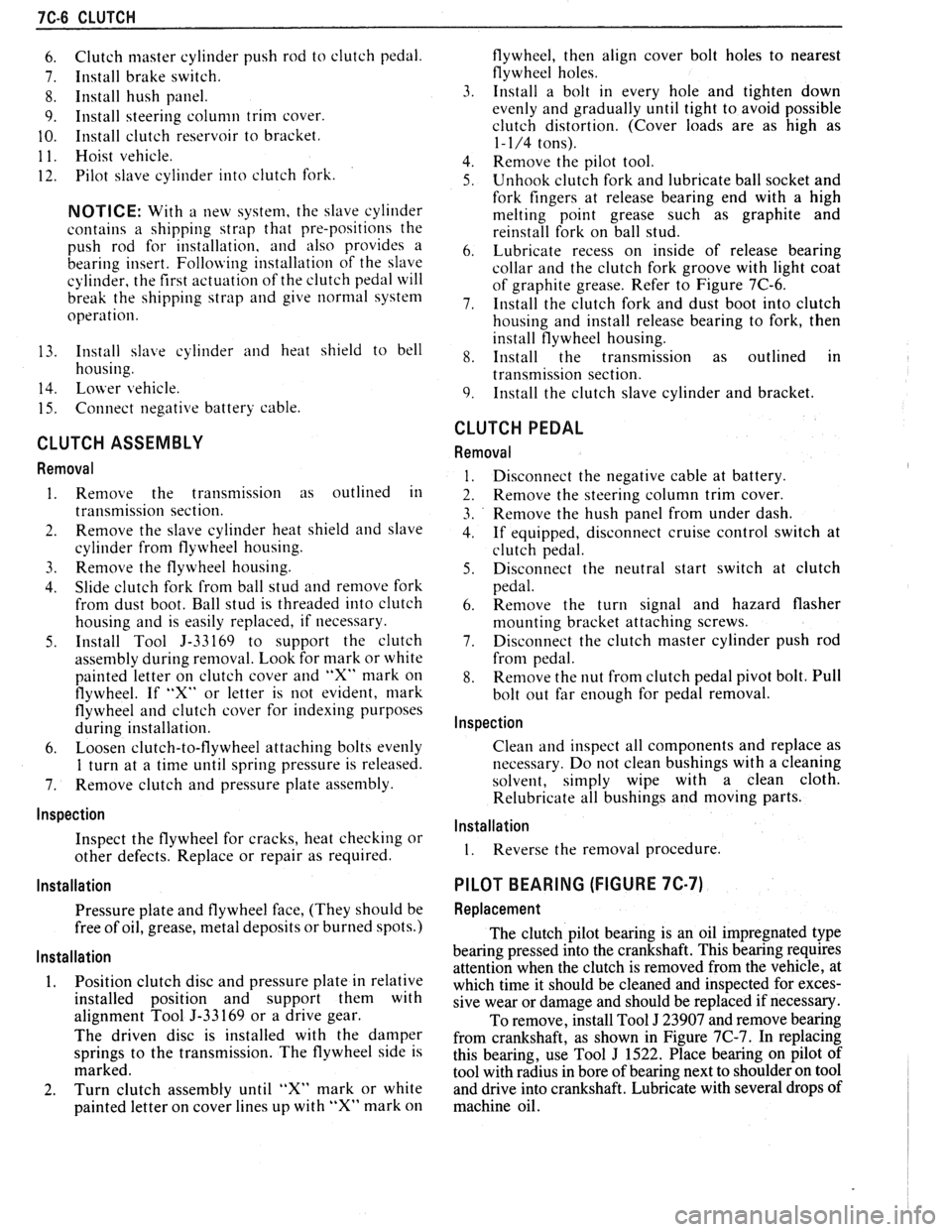
7C-6 CLUTCH
6. Clutch master cylinder push rod to clutch pedal.
7. Install brake switch.
8. Install hush panel.
9. Install steering column trim cover.
10. Install clutch reservoir to bracket.
1 1. Hoist vehicle.
12. Pilot slave cylinder into clutch fork.
NOTICE: With a new system, the slave cylinder
contains a shipping strap that pre-positions the
push rod for installation, and also provides a
bearing insert.
Follojving installation of the slave
cylinder, the first actuation of the clutch pedal will
break the shipping strap and give
normal system
operation.
13. Install slave cylinder and heat shield to bell
housing.
14.
Lojver vehicle.
15. Connect negative battery cable.
CLUTCH ASSEMBLY
Removal
1. Remove the transmission as outlined in
transmission section.
2. Remove the slave cylinder heat shield and slave
cylinder
from flywheel housing.
3. Reniove the flywheel housing.
4. Slide clutch fork from ball stud and remove fork
from dust boot. Ball stud is threaded into clutch
housing and is easily replaced, if necessary.
5. Install Tool 5-33169 to support the clutch
assen~bly during removal. Look for mark or white
painted letter on clutch cover and
"X" mark on
flywheel. If
"Xu or letter is not evident, mark
flywheel and clutch cover for indexing purposes
during installation.
6. Loosen clutch-to-flywheel attaching bolts evenly
1 turn at a time until spring pressure is released.
7. Remove clutch and pressure plate assembly.
lnspection
Inspect the flywheel for cracks, heat checking or
other defects. Replace or repair as required.
Installation
Pressure plate and flywheel face, (They should be
free of oil, grease, metal deposits or burned spots.)
Installation
1. Position clutch disc and pressure plate in relative
installed position and support them with
alignment Tool J-33169 or a drive gear.
The driven disc is installed with the damper
springs to the transmission. The flywheel side is
marked.
2. Turn clutch assembly until "X" mark or white
painted letter on cover lines up with
"X" mark on flywheel,
then align cover bolt holes to nearest
flywheel holes.
3. Install a bolt in every hole and tighten down
evenly and gradually until tight to avoid possible
clutch distortion. (Cover loads are as high as
1- 1/4 tons).
4. Remove the pilot tool.
5. Unhook clutch fork and lubricate ball socket and
fork fingers at release bearing end with a high
melting point grease such as graphite and
reinstall fork on ball stud.
6. Lubricate recess on inside of release bearing
collar and the clutch fork groove with light coat
of graphite grease. Refer to Figure 7C-6.
7. Install the clutch fork and dust boot into clutch
housing and install release bearing to fork, then
install flywheel housing.
8. Install the transmission as outlined in
transmission section.
9. Install the clutch slave cylinder and bracket.
CLUTCH PEDAL
Removal
Disconnect the negative cable at battery.
Remove the steering column trim cover.
Remove the hush panel from under dash.
If equipped, disconnect cruise control switch at
clutch pedal.
Disconnect the neutral start switch at clutch
pedal.
Renlove the turn signal and hazard flasher
mounting bracket attaching screws.
Disconnect the clutch master cylinder push rod
from pedal.
Remove the nut from clutch pedal pivot bolt. Pull
bolt out far enough for pedal removal.
Inspection
Clean and inspect all components and replace as
necessary. Do not clean bushings with a cleaning
solvent, simply wipe with a clean cloth.
Relubricate all bushings and moving parts.
Installation
1. Reverse the removal procedure.
PILOT BEARING (FIGURE 7C-7)
Replacement
The clutch pilot bearing is an oil impregnated type
bearing pressed into the crankshaft. This bearing requires
attention when the clutch is removed from the vehicle, at
which time it should be cleaned and inspected for exces-
sive wear or damage and should be replaced if necessary.
To remove, install Tool
J 23907 and remove bearing
from crankshaft, as shown in Figure
7C-7. In replacing
this bearing, use Tool
J 1522. Place bearing on pilot of
tool with radius in bore of bearing next to shoulder on tool
and drive into crankshaft. Lubricate with several drops of
machine oil.
Page 1798 of 1825
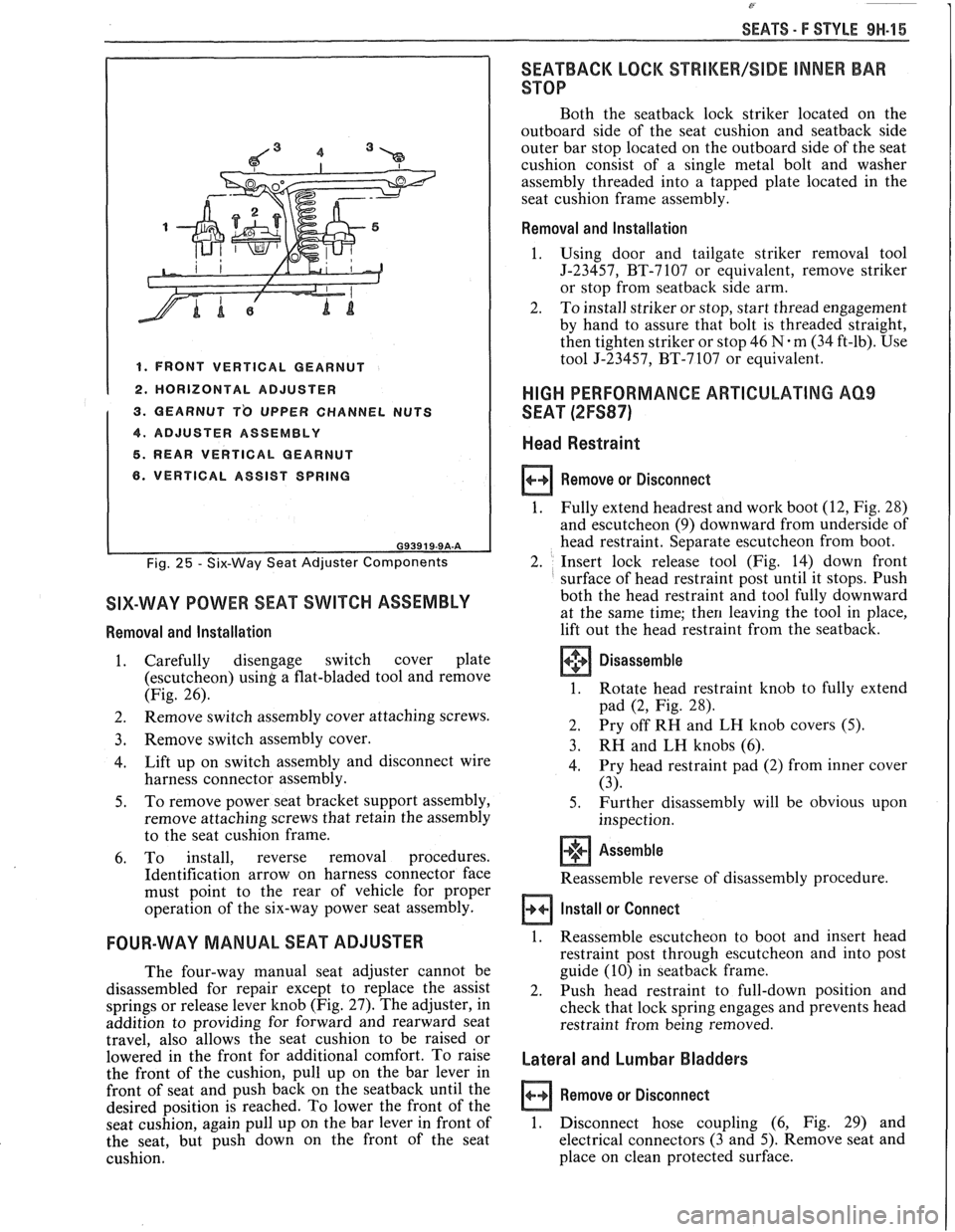
SEATS - F STYLE 9H-15
I 1. FRONT VERTICAL GEARNUT I 1 2. HORIZONTAL ADJUSTER
1 3. QEARNUT T'O UPPER CHANNEL NUTS
1 4. ADJUSTER ASSEMBLY I 5. REAR VERTICAL GEARNUT
6. VERTICAL ASSIST SPRING
Fig. 25 - Six-Way Seat Adjuster Components
SIX-WAY POWER SEAT SWITCH ASSEMBLY
Removal and Installation
1. Carefully disengage switch cover plate
(escutcheon)
using a flat-bladed tool and remove
(Fig. 26).
2. Remove
switch assembly cover attaching screws.
3. Remove switch assembly cover.
4. Lift
up on switch assembly and disconnect wire
harness connector assembly.
5. To
remove power seat bracket support assembly,
remove attaching screws that retain the assembly
to the seat cushion frame.
6. To install, reverse removal procedures.
Identification arrow on harness connector face
must point to the rear of vehicle for proper
operation of the six-way power seat assembly.
FOUR-WAY MANUAL SEAT ADJUSTER
The four-way manual seat adjuster cannot be
disassembled for repair except to replace the assist
springs or release lever knob (Fig.
27). The adjuster, in
addition to providing for forward and rearward seat
travel, also allows the seat cushion to be raised or
lowered in the front for additional comfort. To raise
the front of the cushion, pull up on the bar lever in
front of seat and push back on the
seatback until the
desired position is reached. To lower the front of the
seat cushion, again pull up on the bar lever in front of
the seat, but push down on the front of the seat
cushion.
SEATBACK LOCK %%RIMEW/SIDE INNER BAR
STOP
Both the seatback lock striker located on the
outboard side of the seat cushion and
seatback side
outer bar stop located on the outboard side of the seat
cushion consist of a single metal bolt and washer
assembly threaded into a tapped plate located in the
seat cushion frame assembly.
Removal and Installation
1.
Using door and tailgate striker removal tool
J-23457, BT-7107 or equivalent, remove striker
or stop from
seatback side arm.
2. To install striker or stop, start thread engagement
by hand to assure that bolt is threaded straight,
then tighten striker or stop 46
N.m (34 ft-lb). Use
tool J-23457, BT-7107 or equivalent.
HIGH PERFORMANCE ARTICULATING AQ9
SEAT (2FS87)
Head Restraint
Remove or Disconnect
1.
Fully extend headrest and work boot (12, Fig. 28)
and escutcheon
(9) downward from underside of
head restraint. Separate escutcheon from boot.
2. Insert lock release tool (Fig. 14) down front
surface of head restraint post until it stops. Push
both the head restraint and tool fully downward
at the same time;
then leaving the tool in place,
lift out the head restraint from the seatback.
Disassemble
1. Rotate head restraint knob to fully extend
pad
(2, Fig. 28).
2. Pry
off RH and LH knob covers
(5).
3. RH and LH knobs (6).
4. Pry
head restraint pad (2) from inner cover
(3).
5. Further disassembly will be obvious upon
inspection.
+'+ Assemble [I]
Reassemble reverse of disassembly procedure.
Install or Connect
1. Reassemble escutcheon to boot and insert head
restraint post through escutcheon and into post
guide (10) in
seatback frame.
2. Push head restraint to full-down position and
check that lock spring engages and prevents head
restraint from being removed.
Lateral and Lumbar Bladders
Remove or Disconnect
1. Disconnect hose coupling (6, Fig. 29) and
electrical connectors (3 and 5). Remove seat and
place on clean protected surface.
Page 1801 of 1825
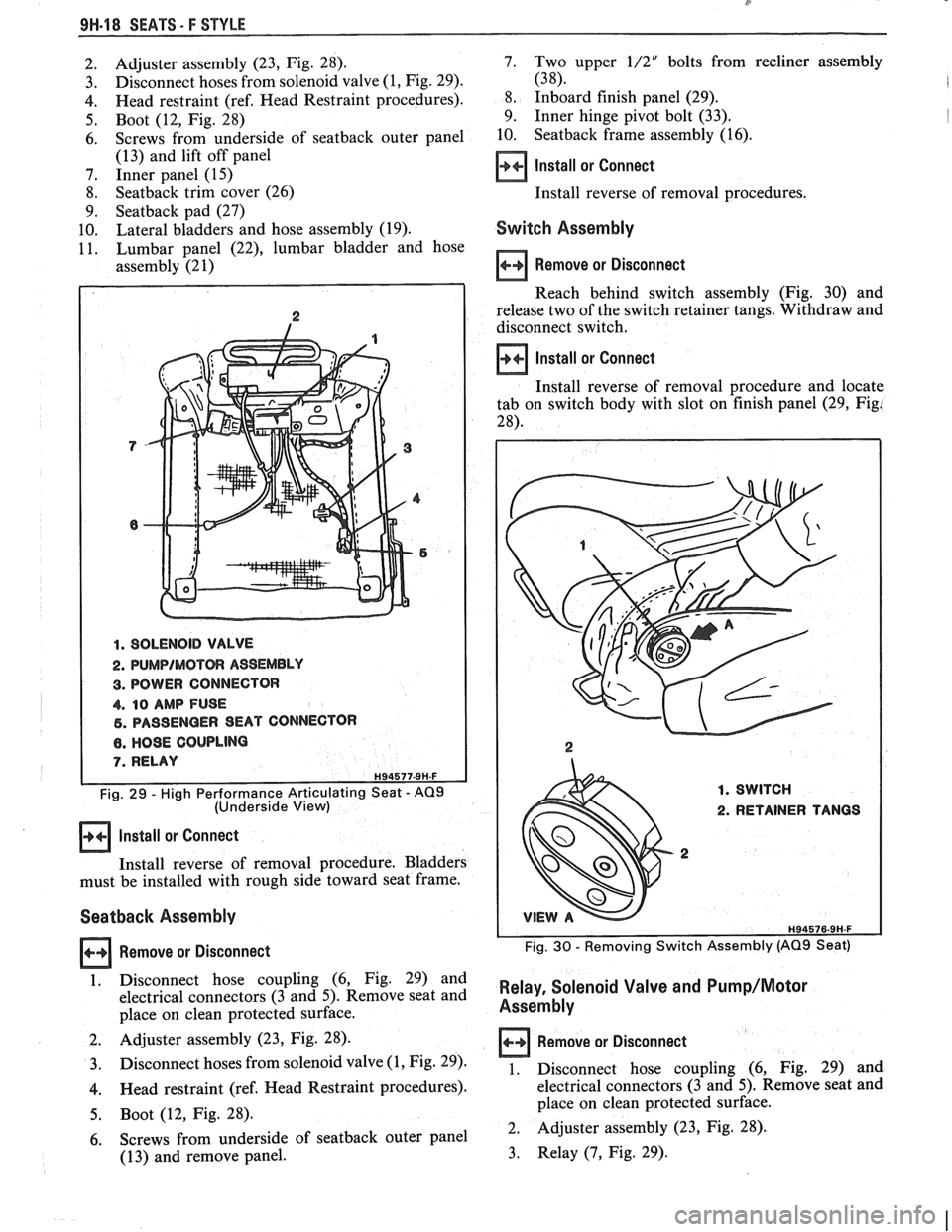
9H-18 SEATS - F STYLE
Adjuster assembly (23, Fig. 28).
Disconnect hoses from solenoid valve
(1, Fig. 29).
Head restraint (ref. Head Restraint procedures).
Boot (12, Fig. 28)
Screws from underside of
seatback outer panel
(13) and lift off panel
Inner panel (15)
Seatback trim cover (26)
Seatback pad (27)
Lateral bladders and hose assembly (19).
Lumbar panel
(22), lumbar bladder and hose
assembly (2 1)
1. SOLENOID VALVE
2.
PUMPIMOTOR ASSEMBLY
3. BOWER CONNECTOR
4. 10 AMP FUSE
6. PASSENGER SEAT CONNECTOR
8. HO9E COUPLING
7. RELAY H94577-9H-F
Fig. 29 - High Performance Articulating Seat - AQ9 (Underside View)
Install or Connect
Install reverse of removal procedure. Bladders
must be installed with rough side toward seat frame.
Seatback Assembly
Remove or Disconnect
1. Disconnect hose coupling (6, Fig. 29) and
electrical connectors (3 and 5). Remove seat and
place on clean protected surface.
2. Adjuster assembly (23, Fig. 28).
3. Disconnect hoses from solenoid valve (1, Fig. 29).
4. Head restraint (ref. Head Restraint procedures).
5. Boot (12, Fig. 28).
6. Screws from underside of seatback outer panel
(1 3) and remove panel. 7.
Two upper
1/2" bolts
from recliner assembly
(38). I
8. Inboard finish panel (29).
9. Inner hinge pivot bolt (33).
I
10. Seatback frame assembly (16).
Install or Connect
Install reverse of removal procedures.
Switch Assembly
Remove or Disconnect
Reach behind switch assembly (Fig. 30) and
release two of the switch retainer tangs. Withdraw and
disconnect switch.
Install or Connect
Install reverse of removal procedure and locate
tab on switch body with slot on finish panel (29, Fig!
28).
1. SWITCH
2. RETAINER TANGS
2
Fig. 30 - Removing Switch Assembly (AQ9 Seat)
Relay, Solenoid Valve and Pump/Motor
Assembly
Remove or Disconnect
1. Disconnect hose coupling (6, Fig. 29) and
electrical connectors (3 and 5). Remove seat and
place on clean protected surface.
2. Adjuster assembly (23,
Fig. 28).
3. Relay (7, Fig. 29).
Page 1802 of 1825
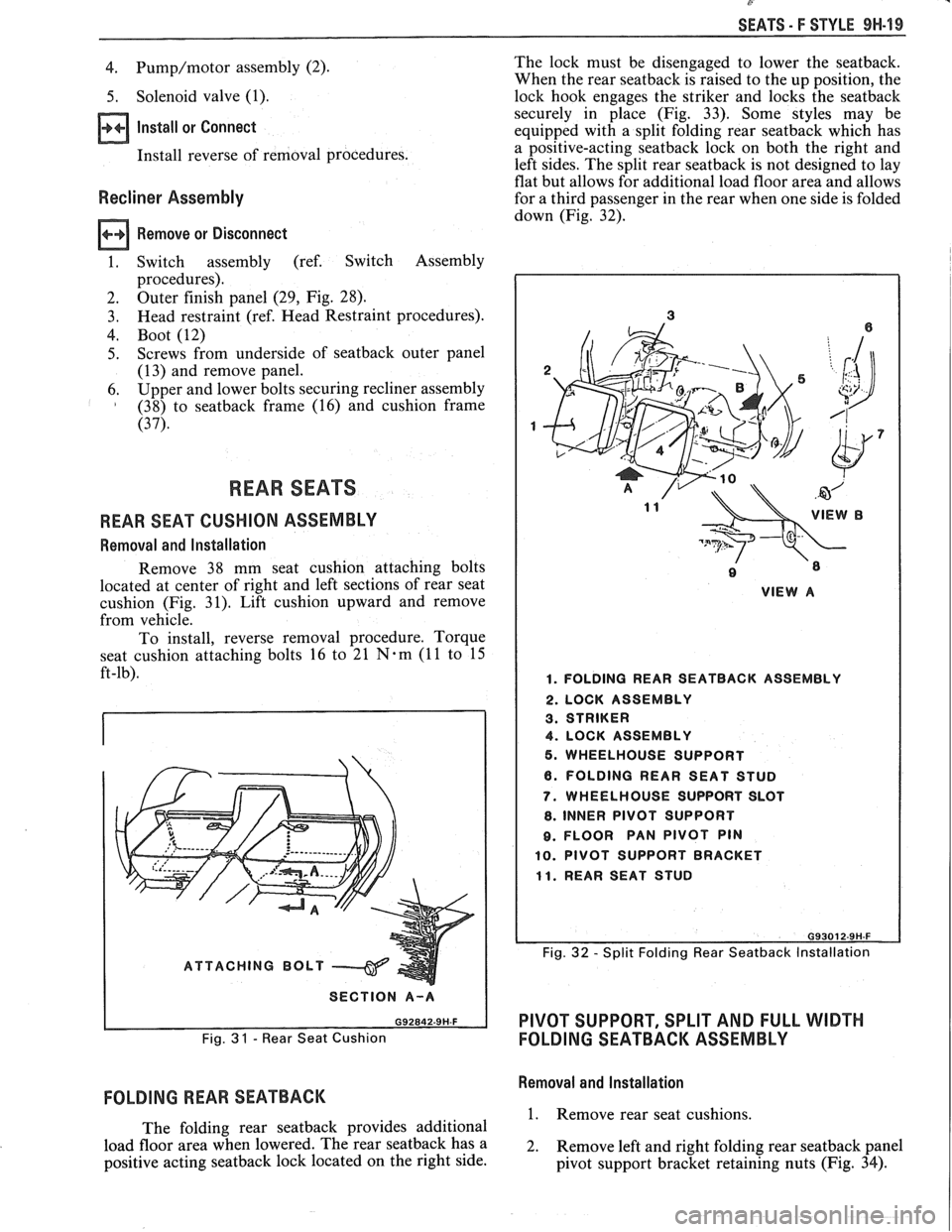
SEATS - F STYLE 9H-19
4. Pump/motor assembly (2).
5. Solenoid valve (1).
Install or Connect
Install reverse of removal procedures.
Recliner Assembly
Remove or Disconnect
1. Switch assembly (ref. Switch Assembly
procedures).
2. Outer finish panel (29, Fig. 28).
3. Head
restraint (ref. Head Restraint procedures).
4. Boot (12)
5. Screws from underside of seatback outer panel
(13) and remove panel.
6. Upper
and lower bolts securing recliner assembly
I (38) to seatbaek frame (16) and cushion frame
(37).
REAR SEATS
REAR SEAT CUSHION ASSEMBLY
Removal and Installation
Remove 38 mm seat cushion attaching bolts
located at center of right and left sections of rear seat
cushion (Fig. 31). Lift cushion upward and remove
from vehicle.
To install, reverse removal procedure. Torque
seat cushion attaching bolts 16 to 21
N-m (11 to 15
ft-lb).
ATTACHING BOLT
I SECTION A-A I
Fig. 3 1 - Rear Seat Cushion
FOLDING REAR SEATBACK
The folding rear seatback provides additional
load floor area when lowered. The rear
seatback has a
positive acting
seatback lock located on the right side. The
lock must be disengaged to lower the seatback.
When the rear
seatback is raised to the up position, the
lock hook engages the striker and locks the
seatback
securely in place (Fig. 33). Some styles may be
equipped with a split folding rear
seatback which has
a positive-acting
seatback lock on both the right and
left sides. The split rear
seatback is not designed to lay
flat but allows for additional load floor area and allows
for a third passenger in the rear when one side is folded
down (Fig. 32).
VIEW A
1. FOLDING REAR SEATBACK ASSEMBLY
2. LOCK ASSEMBLY
3. STRIKER
4. LOCK ASSEMBLY
5. WHEELHOUSE SUPPORT
6. FOLDING REAR SEAT STUD
7. WHEELHOUSE SUPPORT SLOT
8. INNER PIVOT SUPPORT
8. FLOOR PAN PIVOT PIN
10. PIVOT SUPPORT BRACKET
11. REAR SEAT STUD
Fig. 32 - Split Folding Rear Seatback lnstallation
PIVOT SUPPORT, SPLIT AND FULL WIDTH
FOLDING SEATBACK ASSEMBLY
Removal and Installation
1. Remove rear seat cushions.
2. Remove left and right folding rear
seatback panel
pivot support bracket retaining nuts (Fig. 34).